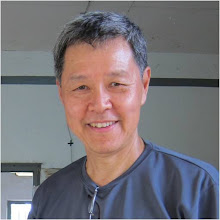The Chinese people have been called various names. Once we were called Orientals; the word 'orient' referring to the East. The original reference to Orientals by the west was with respect to people from the middle east or asia minor- regions East of Europe. In time, the definition shifted eastwards and became more associated with East Asia. Clearly the term has no meaning today and should be completely dropped from the scientific literature. Another term, 'Asians' was sometimes used, although in the United Kingdom, this has come to refer to people from the Indian subcontinent. The term East Asians attempts to shift the definition towards people from China, Korea and Japan. For the most part, Chinese were just referred to as Chinese.
More recently however, another term 'Han Chinese' has emerged. The implication appears to be that the concept of Chinese was inadequate and that somehow a 'Han' preface was needed to distinguish Han Chinese from non-Han Chinese. I suspect this has arisen as a result of more scientific work from China, where it was necessary to distinguish the main Han ethnic group from the other 56 ethnic groups which were not 'Han'. The following chart shows the increasing use of the term 'Han Chinese' in the literature beginning from about 1980 and rising steeply over the last 10 years.

In Singapore we don't really care to be Han Chinese, other than using the term to be consistent with 1 billion other people who want to use the term. For us, we are just plain and simple Chinese.
The term Han Chinese actually takes reference to a wish to be associated with the legendary 1000 year Han dynasty which ended in 220CE. I think this is more important to the mainland Chinese, more of the northern sorts. Interestingly for many of us more southern type Chinese, of the Min-nan dialects, the term 'Tang people' '唐人' is more frequently used. This is in reference to another wonderful period of Chinese history called the Tang dynasty (618-904).
So there isn't a whole lot of consistency with respect to how Chinese people want to refer to themselves. Tracing an ancestry back to a dynastic period is not an ethnically reasonable proposition since there can be no assumption that people from that dynasty were necessarily ethnically homogeneous.
It is somewhat of a wishful thinking that the Chinese people, whether Han or Tang, are a biologically homogeneous bunch of people. For large stretches of Chinese history, the country had to deal with more belligerent northern neighbours, and had been conquered by Mongols and Manchus from the North. These people, clearly of a different ethnicity from the indigenous Chinese, not only tended to displace the populations southwards and also widely assimilated with the resident Chinese. The more southern Chinese didn't have the benefits of the Great Wall so there was really nothing to keep them from mingling with their more southern non-Han neighbours.
As a result of these admixtures, there is a north-south cline in East Asian populations. In China itself, there would appear at the very least, among the "Han Chinese", to be a distinction between northern and southern Chinese. The watershed for these two groups is not a clear one, but appear to be somewhere in the vicinity of the Yangtze or Chang Jiang river divide.
It is important to be aware of the existence of this cline because it affects the way we look at "East Asian" population data. While for the most part, Chinese data tend to cluster quite closely together (which is not surprising), we need to be careful about too readily extrapolating northern data to a southern Chinese population, and vice versa. In many situations, northern Chinese data seem to be more in alignment with data from Japan and Korea, while southern Chinese data aligns with Hong Kong, Taiwan and Singapore.
Singapore, being the most southern of the major 'Han Chinese' populations, may have some unique features potentially because of some degree of genetic admixtures with the resident austronesian populations in south east Asia.
















